головные уборы
The Kazakhs had the following types of clothing: underwear, outerwear, cloth, clothing «on the way out», elegant and ceremonial. According to Kazakh customs, a man dressed in the best clothes when he entered into single combat, went to war. Underwear includes: robe, trousers, vest, velvet kazakin; outerwear-robe, kupi, tank top, jacket, fur coat, homespun woolen robe; cloth clothing includes: chekmen, kebenek, kenaf, cloth. Clothing is made of fur, wool and silk fabrics, felt, fur. Kazakhs especially appreciate the skins of kulan, saiga, tiger, raccoon, sable, marten, and white mouse. Fur coats were made from the skins of these animals. Clothing with a valuable fur lining was called a fur coat. Depending on the fur, fur coats were divided into sable, wolf, and ferret. Outside, the fur coat was covered with cloth, three types of velvet, satin, blue velvet, red silk and other valuable materials. Fur coats were usually sewn with a turn-down collar edging. In all the splendor and ornamentation of Kazakh clothing, in each of its ornaments, there is a unique reflection of the history and thoughts of our people. This is our national culture.
Men’s felt cap with slits on the brim.
Lightweight men’s felt headdress. This hat is made of white felt with a thin print. It consists of two main parts. This is the top of the cap and the margins (sometimes there are curved margins). The top of the cap consists of four parts. A masterfully sewn cap, it is divided into four parts, each part is sewn with black velvet. Then the top of the hood turns out to be dome-shaped. The brim of the cap is made of white felt, round shape, flat four-layer shape, with a pattern applied to the upper part of the brim. To make the hat fashionable, the lower part of the headdress is sometimes covered with black velvet. On the top-a fringe of black or other color, and on the margins-four edging, embroidered with various silk threads. White felt hat – light, cool and fashionable. Recently, local industrial enterprises have been making hats from felt of different colors.
Leather Pants
Well-tanned, tanned leather was called zhargak by the Kazakhs. Trousers made of similar leather, painted in pink, with a color pattern, were called «slang pants». At the time, this trendy clothes wore heroes, Becky and Biy, akyns-segali.
Men’s felt cap with slits on the brim.
Lightweight men’s felt headdress. This hat is made of white felt with a thin print. It consists of two main parts. This is the top of the cap and the margins (sometimes there are curved margins). The top of the cap consists of four parts. A masterfully sewn cap, it is divided into four parts, each part is sewn with black velvet. Then the top of the hood turns out to be dome-shaped. The brim of the cap is made of white felt, round shape, flat four-layer shape, with a pattern applied to the upper part of the brim. To make the hat fashionable, the lower part of the headdress is sometimes covered with black velvet. On the top-a fringe of black or other color, and on the margins-four edging, embroidered with various silk threads. White felt hat – light, cool and fashionable. Recently, local industrial enterprises have been making hats from felt of different colors.
Leather Pants
Well-tanned, tanned leather was called zhargak by the Kazakhs. Trousers made of similar leather, painted in pink, with a color pattern, were called «slang pants». At the time, this trendy clothes wore heroes, Becky and Biy, akyns-segali.

Malachai
The Kazakhs have many types of malakhai, the most valuable of which is the fox malakhai. On the inner side, fox fur is sewn, and on the outer side – velvet, plush or other noble fabrics. Up you maka consists of four or six parts (separate) of the three end (felt fabrics, is pointed.

Felt boots
These straight shoes, without heels, are like boots, long, with a thick sole covering the knee. This shoe does not have a division into the right or left foot. It is worn with felt stockings by-pass. In frosty winter weather, such shoes are warm and comfortable for riding.
Boots
Felt boots are worn under the ichigi for warmth. The felt of the baibak you wear in winter is thick, and the felt of the baibak you wear in summer is thin. There are two ways of sewing. One of them is an insole with a split sole; the second is a solid insole. The seam of the bypass passes from the outside, so as not to put pressure on the legs. For sewing, use yarn made of camel or sheep wool. Woolen by-passes have a short shaft. Previously, it was used to be worn from a felt bypass instead of socks. Currently, this is a variant of boots, half-boots, they are worn under the ichigi. The bypass is made of camel wool, sheep wool, and goat down. These bypasses are warmer, lighter, and softer.
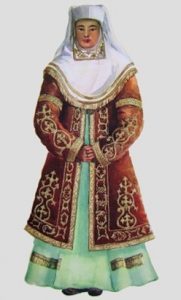 Kimeshek
Kimeshek
A headdress worn by
(elderly) women. It is sewn
from a single piece of
fabric covering the entire
chest. The front side is cut
out of the white fabric.
The front part is embroidered with an ornament. On the upper part, for decorative purposes, a white cloth is wrapped, for example, shylauysh (a large white handkerchief) or kundik.
Borik

Kazakh ancient national headdress made of valuable fur and skin of young animals . It has summer and winter views. Depending on the type of skin, the cap has different names. Borik from the skins of otters, Borik from the skins of Martens, Borik of raccoon skin, Borik from the skins of foxes, Muscovy Borik etc. It is worn by both men and girls .
Ichigo
One of the types of shoes, sew it from leather, shagreen. Outside, they put on galoshes. The shoemaker, when sewing ichigi, first of all, cuts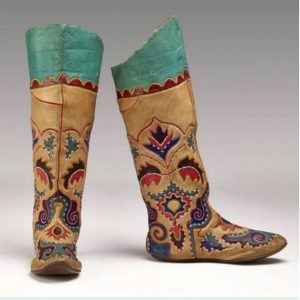 out the upper part, the bottom — from thin leather, the insole — from thick leather. Then he applies the upper part with a seam inside. After that, he sews the bootleg When he sews the bootleg, he puts welts between the seams. Ichigi – light and soft shoes. They are particularly suitable for cleanliness. In recent years, local businesses have started to produce more and more ichigi. The demand for this type of footwear is growing from year to year
out the upper part, the bottom — from thin leather, the insole — from thick leather. Then he applies the upper part with a seam inside. After that, he sews the bootleg When he sews the bootleg, he puts welts between the seams. Ichigi – light and soft shoes. They are particularly suitable for cleanliness. In recent years, local businesses have started to produce more and more ichigi. The demand for this type of footwear is growing from year to year
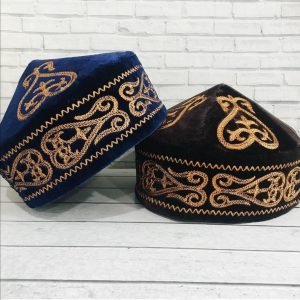
Skullcap
Men’s lightweight headdress. There are many types of skullcaps. Skullcap with high top, flat top and pointed top. In the skullcap, which is worn by men, there are only tenge, beads. But they are embroidered with such patterns as» horn»,» horse»,» ivy», decorated with machine, hand stitches — «tandai»,»irek». The skullcap is made of plush, and the lining is made of silk, satin. Currently, local enterprises produce various skullcaps .
Chapan.
Chapan is the national dress of the peoples of Kazakhstan and Central Asia. Between thick fabrics, wool, cotton are laid, lined or sewn with a double lining. It has a mostly vertical collar, partly a turn-down collar. Chapan is divided into: quilted chapan, covered chapan, fitted women’s chapan made of expensive material.
A fitted chapan with a slit for girls is sewn from multi-colored yarn, the clasp on the collar-sleeve, the hem with two buttons. Instead of a button, a silver clasp (hook) is put on, on which precious stones are installed. Currently, chapans are sold (without lining made of wool, cotton) with two sections and sleeves with embroidery or a clasp. Among the Kazakh people, the tradition of giving chapans to respected people is widespread.
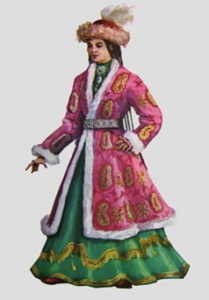 Camisole
Camisole
National clothing, common among the Kazakh people in the 18th and 19th centuries. Information about the camisole is found from the middle of the 19th century. The camisole is found not only among the Kazakhs, but also among other Turkic peoples. In women’s clothing, the camisole occupies a special place, it simultaneously performs decorative and utilitarian-practical functions. This is a light summer clothing with a lining, without sleeves. Hem and edges embellished with stones, lace, silver coins (sliceby), hung with various fur decorations.
Hat
Men’s headdress. The headdress of men was made from the skin of animals, such as sable, beaver, raccoon, fox, korsak – steppe fox, marmot, as well as domestic animals – the wavy skin of a calf, goats-lambs. The upper part is cut in two ways. There are the following types, consisting of several parts with rectangular or rounded edges, on which a round top is installed. On the skin, wool and cotton wool are packaged, sewn between the linings. The outside is covered with leather, put on the pad and stretched.
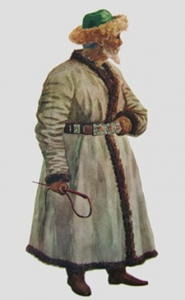
Fur Coat
Fur coat-one of the types of national Kazakh costumes, it is sewn from merlushka, smushka, fur, various fabrics, the outside is covered with fabric. Depending on skin type, which is sewn from the fur, it is called maruskova coat, fur coat of smusic, wolf fur coat, Fox fur coat, fur coat and paws animals, forest fur coat, raccoon, sable, etc. The skin from which the fur coat is sewn is cleaned of flaking fat, blue, then kneaded with fermented kefir. When the skin is completely enveloped, it is combed, massaged with hands, stretched and softened. The fur coat is sewn in large stitches, all seams are turned inward. A collar made of beaver or sable is applied to a wolf or fox fur coat, a fur coat made of furs, as well as to other types of fur coats. Berlusconi, walchli coats were worn by men fur coats from other types of fur wore women. The fur coats worn by women and young girls were very elegant. The necks, sleeves, and hem of women’s fur coats were decorated with beaver and marten fur. The underside of the fur coat was sewn with silk threads. The merlushka fur coat was made from the wavy skin of lambs that had not yet grown up. A fur coat made of furs-sewn from the skin and skin of grown-up lambs. The forest coat made from the skin of the neck Fox fur coat legs — made from the legs of a Fox.
NATIONAL CLOTHING OF THE RUSSIAN PEOPLE
Traditional Russian Women’s Clothing
Traditional Russian clothing not only protected from heat and cold, it also told about a wearer’s marital status, age, and origin. Each type of clothing had characteristic details and a special design. Not least important was the choice of cloth, while the decorations, finish and cut each had symbolic meanings.
According to researchers, traditional Russian dress took shape roughly in the 12th century. Up until the 18th century, this clothing was worn by all members of society, from the poorest peasants to the richest boyars and rulers. After a decree by Peter the Great in the late 1600s, traditional Russian attire was replaced by European clothing. Peter was convinced that the older “folksy” dress wasn’t suitable for a country that was trying to be an economic and cultural partner with Europe. Some researchers think that this was in fact not a political move, but just an expression of Peter’s own taste. From this time onwards, traditional Russian dress became only for peasants, and was preserved only among the lower classes. This decree was enforced by strict fines for making or selling traditional Russian clothing.
There were two main types of Russian clothing: for celebrations and for everyday wear. Both types of clothing were made of multiple layers of cloth, and could either be straight fitting or have a flare. Emphasizing the waist was not common. Brightly colored cloths were preferred.
The hem of shirts, as well as the collars and sleeves, were richly decorated with embroidery, plus braids, sequins, and buttons. Patterned inserts were also used while sewing clothing, while for a festive costume, the front of the shirt would be entirely covered in designs.
Each region had its own designs and ornaments that were used for decorating Russian clothes, and color schemes could also vary. In the villages and towns around Voronezh, clothing was decorated with black embroidery, which was considered to be very elegant. In northern and central areas, people preferred more bright variations, including embroidery with gold thread or brightly-colored silk or cotton. The most common colors were red, dark blue, and black.
In southern Russia, traditional women’s clothing consisted of a long, plain shirt and a long skirt, made of three pieces of cloth stitched together. This was the most common clothing for married women. The hem would often feature embroidery and other decorations. The cloth of the skirt contained wool, in comparison to the shirt, which was made of just cotton. A wool string, called a gashnik, held the skirt in place, and an apron was often worn over the skirt. In the south, the shirt was also often richly embroidered with designs.
Sarafan
- The traditional Russian sarafan, or pinafore dress, unsurprisingly has eastern roots. The word “sarafan” means “dressed entirely”. There were several different types of sarafans:
- Trapezoidal sarafans (“plowing sarafans”) were worn in the Urals. The seam that joined the two pieces of fabric was joined in the front of the garment, and was decorated with buttons or ribbons.
- The “deaf” sarafan didn’t have a seam in the front. This garments was made of one large sheet of cloth.
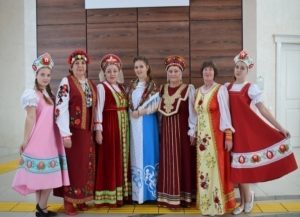
- The “circular” sarafans were comfortable to wear because of their large size and shoulder straps.
- The color of sarafans depended on whether they were for everyday use or for special occasions. The most popular colors were red, light blue, dark blue, and dark red. Everyday sarafans used rough cloth or calico, while ones for special occasions used brocade or silk. On top of the sarafan women would also wear a dushegreika, or cardigan, which could be made from either rich or simple material.
Everyday and Special Russian Clothing
There was a very distinct line in traditional Russian dress between clothing for everyday use and clothing for special occasions.
Everyday clothing was simple, and there were fewer pieces to be worn (no more than seven). The materials were inexpensive, and the design made them comfortable to work and move in.
For special occasions, there could be 20 or more elements to be worn. More expensive cloths were used, including wool, brocade, and velvet. These outfits were only brought out for special celebrations and festivals, and the rest of the time they were stored in large chests. Some types of dress were for rituals and special events, such as attending church, funerals, or christenings.
Traditional Russian men’s clothing
Traditional Russian men’s clothing was practically identical across all of medieval Russia. The basic outfit consisted of pants, a shirt, a hat, and a belt.
If women could decorate even the most simple everyday clothing, then men’s traditional clothing differed in its asceticism. Only young men who hadn’t yet gotten married could wear bright and handsome clothing, including ribbons on their hats, scarves around their necks, jewelry, and other items. For example, in villages around Kursk, rich men wore silver bracelets to show their family wealth.
Grown men, even those with money, dressed humbly. Even clothing for special occasions barely differed from regular, everyday outfits. The main change was the type of fabric used, as holiday outfits used items made in factories.

Traditional Russian clothing for men featured simple cuts. The shirt worn by men had the shape of a tunic, and was made from basic canvas, folded along the weft. In the center of the piece of cloth was a hole and a small cutaway. To make the clothing bigger, tailors would add side seams and triangular wedges. In some places, tailors would also add a slit on the right or in the center.
The collar of the shirt wasn’t high, and was maximum 2 cm (0.75 in) tall. Buttons were used to close the collar.
Traditional Russian clothing not only protected against heat and cold, but also conveyed information about the person wearing it. For example, single men and young boys wore long shirts that reached above the knees. Older men and married men wore shirts that covered the knees. In some regions, young men wore shirts so long that they didn’t even need to wear pants, though this was an exception rather than the rule. Quite often, the first pair of pants was gifted to a boy after the age of 6.
Traditional pants were made of two rather thin legs, each cut of two pieces of cloth. The instep was made with diamond-shaped inserts, rather like modern gussets. As elastic did not exist, the pants were held up with a special rope, called a “gashnik”. A small pocket for combs, wallets and keys could be attached to the gashnik.
Among peasants, traditional Russian clothing was made from homemade cloth, such as hemp, cotton, or linen. In the 19th century, homemade cloths were replaced with manufactured cloths that were cheaper. Homemade cloths were only used for special clothing and rituals, such as funeral clothing.
Belts
Men always wore their shirts untucked, covering their pants. Traditional Russian dress required a belt, with the knot on the left side. It’s unsurprising that there is a saying in Russian that means “to untie oneself”, which means to act rudely or break rules.
Belts were made of cloth, knitted, or woven from threads, cords, or pieces of leather. By the beginning of the 20th century, regular leather belts had already replaced traditional belts in Russian dress. The traditional belts had been filled with meaning since pagan times, and were charms and talismans that were given at weddings or other ceremonies. After a wedding, the bride would give all the guests belts as gifts (even if this meant giving away more than 100 belts). The groom was presented with a belt, which, legend has it, had extra protective powers. Some people would weave names, prayers, or passages from holy books into belts, and children were dressed in a belt for their christening.
But the funeral clothing, also an important part of a Russian’s traditional clothes, did not include a belt. Funeral clothing included no ties, clasps, or buttons.
Wedding clothing for men was similar to standard clothing, and included a pair of pants and a shirt. The shirt had to have long sleeves. The front of the shirt, as well as the hem on the sleeves, was richly decorated with embroidery and inserts. The belt was wide and long, and was also decorated. Often, these ornaments included texts, symbols, and charms woven into the belt.
NATIONAL CLOTHING OF THE DUNGAN PEOPLE
Men’s and women’s clothing is close to the North Chinese: right-wing (for men also straight-cut) robes and jackets, wide trousers, clothed shoes without a heel; Black and blue colors predominate, women’s clothing is decorated with embroidery. Headdresses — solo hats, fur and felt hats. Young women walked with their heads uncovered, older women wore headscarves.
All Dungan traditional clothing was divided into three groups: summer, demi-season (spring-autumn) and winter. It was distinguished by the simplicity and some similarity of men’s and women’s suits: trousers, single-breasted and double-breasted clothing, and outerwear.
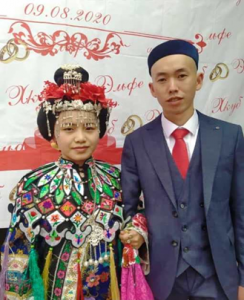
Dungan men’s clothing has undergone the most changes and is completely out of use these days. But in the first years of life in Semirechye, Dungan men wore Manchu attire and wore a braid. The preservation of such attire was dictated by the isolation and compactness of the Dungans in the Semirechensk region. However, over time, the Dungans, especially the men, began to imitate the local Turkic peoples. Already at the beginning of the 20th century. Dungan men wore Tatar camisoles, Kyrgyz fur coats, Uzbek ichigs with galoshes and fur hats, Russian boots, and wealthy townspeople wore European suits.
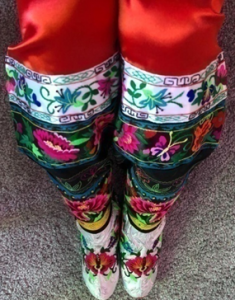
Dungan women’s shoes are varied in shape and colorful in design. Embroidered weekend shoes in combination with national clothes look exceptionally elegant. Women’s cloth shoes are made of silk and cotton fabrics; Dungan women also wear shoes made of black velvet. They are very original. Bright shoes for brides are very beautiful. It is hand-embroidered with rich colors of flowers and ornaments. This shoe is a continuation of the wedding dress, which is made by hand and trimmed with traditional appliqués.
NATIONAL CLOTHING OF THE TURKISH PEOPLE
The traditional clothing worn by the Turks was generally characteristic in its cut for other autochronic groups in the region. Everyday men’s clothing included a Circassian coat made of woolen fabric («chokha» — cargo, and general Caucasian), a «jacket» («arhalukh» — a term of Turkic origin, which has a regional distribution), trousers («shalvar» — Turkish, and general regional.) , sheepskin or cloth vest (“yelek” — Tur.).
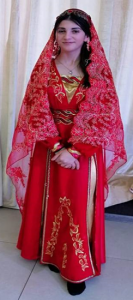
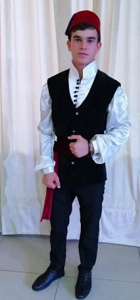
The most common headdresses are a hat with headphones (“kabalah” — Georgian), a hat (“papakh” — regional). Women’s clothing is a tunic-shaped shirt (“terek” or “kulmek” — probably from the Turkish “gemlek”), a dress (“kaftan” — Turkish), trousers (“fog” — regional). The headdress included a small round skullcap (“katha” — region-wide), a veil scarf covering the chin (“lechek” — a term found among various peoples of Central Asia and the Caucasus, including Georgians, Kurds and some groups of Turks in Eastern Anatolia), a headscarf (“poshi” is probably a local name) and a cape-veil “zgram” — found among different groups of the region). Traditional men’s shoes are made of rawhide (“chorukh” — region-wide); women’s — shoes «kondura» — tour.).
Modern Turkish clothing: jackets, trousers, shirts, etc. Some older people wear turbans and fez. The main headwear is a cap, a hat, and berets. Young people, especially in cities, walk around with their heads uncovered. Older people prefer astrakhan hats. In women’s clothing, national characteristics have been better preserved: shawls, modest long and closed dresses, women go outside (even in summer) in long cloaks or anthers that hide their figure.
The national women’s costume has been preserved mainly in rural areas. This is a holos: a scarf, a long wide dress.
The women’s costume of the Ahiska Turks traditionally consists of trousers, a wide shirt and a wide long dress, on the head there is a large scarf and a headdress made of gold coins. Men wore pants, shirts, and sashes; they wore hats or fez on their heads. Nowadays, more practical clothes are usually preferred to national attire. However, women still wear headscarves.
NATIONAL CLOTHING OF THE UZBEK PEOPLE
Men and Women’s Tradional Costume.
Uzbek National Headwear
Traditional uzbek clothes are very bright, beautiful and cozy. Uzbek clothes are a part of rich cultural traditions and life style of Uzbek people. In urban places it is uncommon to meet people in traditional Uzbek clothes, now it is worn on traditional festivities and holidays. But in rural places it is still a part of everyday and holiday garments.
Uzbek Men’s Clothing
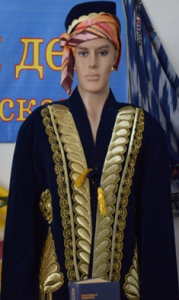
The basis of national men’s suit is a chapan, the quilted robe, tied with a kerchief. Traditional men’s cap is tubeteika. Kuylak is the men’s straight cut undershirt. Ishton is men’s wide trousers, narrowed at ankles. Traditional footwear is high-boots, made of thin leather. Shirts were worn everywhere, but men from the Fergana Valley and Tashkent region wear a yakhtak, a wrap shirt. Both of these types were sewn from homespun cotton cloth and feature a moderate aesthetics in a form of a decorated miniature braiding- jiyak, stitched along the collar.
Belts for gala dresses were normally very smart, made of velvet or embroidered, with silver figured metal plates and buckles. Everyday shirts are tied with long sashes.
Uzbek Women’s Clothing
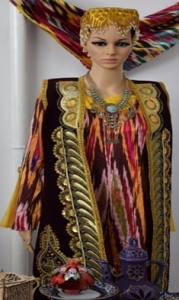
Traditional Uzbek women’s suit consists of plain khan-atlas tunic-dress and wide trousers. Holiday garments were made of satin fabric richly embroidered with golden thread. Women’s headdress consists of three elements: a skull-cap, kerchief and turban. An essential part of traditional holiday garments of Uzbek women are gold and silver jewellery: earrings, bracelets, necklaces. Surkhandarya women most of all prefer the colors of red nuance as a symbol of well-being. The embroidery pattern was chosen not by chance, it always had magic or practical function. One could judge about the owner’s social status by the patterns, though sometimes they bear other meanings. For instance, repeating geometrical pattern on the braiding was a something like an amulet Clothing of black or dark blue colors was not popular in any region of Uzbekistan due to a superstition. Sogdian patterns have preserved the traces of Zoroastrian influence. The colors in this region were chosen on the basis of the position in society. For example, prevailing blue and violet nuances in a woman’s dress showed her husband’s pride of place, while greenish motifs were frequently used by peasants and craftsmen.
The footwear consisted of mahsi (ichigi – nice heelless step-in boots with a soft sole), and high boots made of rough leather or rubber. It was very handy and warm footwear which is quite popular even today.
Women and Men’s National Headwear. Tubeteikas (Skull-caps)
Headdress is one of the main elements in the traditional Uzbek clothing. The national headwear in many countries of Central Asia, including Uzbekistan is a tubeteika (skull-cap). Tubeteika is derived from the Turkic word “tubé”, which means “top, peak”. Tubeteika is worn by everybody: men, women, and children. Only elder women do not wear tubeteikas.
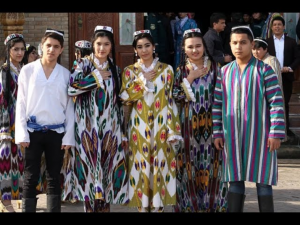
Today it is uncommon to meet a man in the tubeteika in large cities, mainly it is an important element of holiday garments at family parties and religious celebrations. The common form of the Uzbek tubeteika is tetrahedral and slightly conical. Traditional men’s tubeteika is black and embroidered with a inwrought white pattern in a form of four “paprikas” and 16 miniature arches. An everyday tubeteika, “kalampir”, is one of the simplest and widely used cap, its importance must not be underestimated. This tubeteika is an essential attribute for some events even in the environment of a country-wide influence of the European culture. There are smart tubeteikas enriched with bright and colorful embroideries and patterns for special festival occasions. Each region of Uzbekistan has its own national headdress ‘tyubeteyka’ (in Rus) in height and pattern. Despite the wide range of variety it is considered that there are only six main schools of tyubeteyka embroidery in Uzbekistan: Ferghana, Tashkent, Kashkadarya-Surkhandarya, Samarkand, Bukhara and Khorezm-Karakalpak. For special, festive cases there are smart tyubeteykas that are rich in bright and gold embroidery and patterns.
NATIONAL CLOTHING OF THE KURD PEOPLE
The clothing of the Kurds depends on the social status of the Kurd or Kurdish woman, their tribal and religious affiliation and age.
Men’s clothing consists of trousers and a shirt made of white cotton fabric. A sleeveless vest is worn over the shirt, then a caftan with slits at the hips and wide sleeves. Over the caftan, wealthy people wear a cloth jacket trimmed with multi-colored cords.
A mandatory element of a man’s suit is a long (often about 30 m) woolen or cotton belt, which the Kurd repeatedly wraps around the waist. A dagger, a pipe and a pouch are tucked into the belt. A dagger, a pipe and a pouch are tucked into the belt. Men wear felt or felt caps of various shapes, wrapped in bright fringed silk or wool scarves. Woolen socks and leather shoes or boots are put on the feet. The festive clothing of a wealthy Kurd differs from everyday clothing in its colorfulness. The urban Kurdish population wears predominantly European-style clothing.
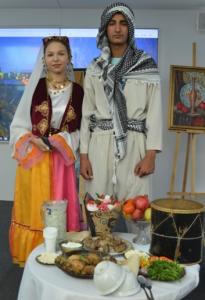
Women’s costume, depending on their tribal affiliation, comes in various colors — red, green, yellow, blue, black, etc. Women’s clothing consists of calico or satin trousers of various colors (Yezidi women wear trousers only in white); shirts; a woolen or velvet sleeveless vest, trimmed with mother-of-pearl buttons on the front; sweatshirts; numerous gathered skirts, made either from chintz and satin, or from silk. Instead of skirts and jackets, they sometimes wear a wide dress, cut from top to bottom and gathered at the waist. An apron is worn over skirts or dresses. In addition, girls wear a long woolen belt around their waist, and women wear a woolen shawl over the belt, hanging on the lower back in a triangle. On their feet they wear woolen socks with black or bright patterns and leather shoes.
The women’s headdress has the shape of a beveled cylinder, complex in design and decoration. It is made of bast (plywood, thin tin) and lined outside and inside with brightly colored cloth. Several rows of coins are sewn onto the front of the headdress, and multi-colored silk scarves are wrapped around it on top. Elderly women and old women do not sew coins and tie white scarves around their headdress, arranged in a strictly defined order. Girls wear red fezzes trimmed with coins and wrapped in silk scarves.
Kurdish women wear numerous decorations: forehead, ear, neck, chest, hand, waist, and ankle. Mandatory elements of jewelry are coins, mother-of-pearl buttons, beads, and seed beads. Most Kurdish women wear a rosette-shaped nosepiece with a semi-precious or precious stone. Kurdish women fill their eyebrows and eyelashes and paint their palms with henna.
Modern Clothing

Kurdish women’s dress, modernized with minimalist style
Modern Kurdish women’s dress is traditional. It is, however, still fashionable amongst the Kurdish community. Kurdish women and men often have a large collection of Kurdish clothing and frequently seek out new designs and fabric. They usually buy the fabrics of their choice and then have clothing tailored, as there are tailors who specialise in Kurdish clothes. Recently these respected tailors have turned into designers, creating variations on the conventional structure of the dress. In villages, women usually tailor for their entire family after everyone chooses their fabric.
NATIONAL CLOTHING OF THE AZERBAIJAN PEOPLE
Traditional azerbaijani clothes are very beautiful and original. Female dresses are graceful in silhouette and cut, emphasizing supple waists of Azerbaijani beauties. They are decorated with intricate embroidery trimmed with beautiful «gold» bands.
Menswear is also very original. It emphasizes courage should not be too tight to constrain swift movements.
Women’s wear was made basically of silk and velvet, the man’s — from cloth and home-made cashmere fabric.
A remarkable element of Azerbaijani clothes is underwear. Both female and male it was made of linen and cotton fabrics. Rich beauties could afford silk ones.
Azerbaijan traditional clothes — Women
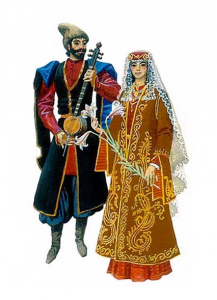
The style reflected the marital status and age of the owner. A young girl’s wear noticeably differed from a married women’s. Young women dressed the most brightly and elegantly.
A woman’s clothes included: an over shirt, arkhaluk, chepken, lebbade, kyuleche, kyurdu, ashmek and bakhari.
The shirt used one button on the collar. The sleeves were normally long, wide and straight. The front bottom part of the shirt was decorated with silver or gold coins.
Tight fitting chepken (caftan) was worn over the shirt. On the sides chepken had sleeves ending in oversleeves. It was made of velour and various glittering fabrics.
Arkhaluk is considered one of the most widespread kinds of clothes in Azerbaijan . It was also tight fitting and had a lining. Some arkhaluks had straight wide cut and slits on both sides. Arkhaluks were made in different sizes.
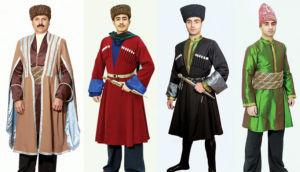
Lebbade (dressing gowns) were quilted and lined. The collar of lebbade was open was tied in the waist with a band. The sleeves of lebbade were short. Lebbade was sewed from velour and different glittering fabrics. The collar, sleeves and hems were trimmed with a band.
Ashmek is quilted outer clothing. The inner part, the collar, the sleeves and the hem of ashmek were trimmed with fur.
Kzurdu is a quilted sleeveless women’s wear with open collar and slits on doth sides. Kyurdu wes made of velour.
Bakhari s a quilted lined women’s wear. The sleeves were straight down to knees, the collar was open. Bakhari was mainly made from velvet. The collar, the hem and the sleeves were trimmed with various bands, edgings and chains.
Kyuleche is upper women’s top with goffered hem. It had down to knees length; the sleeves were below elbows.
Tumans (skirts) which were worn by Azerbaijani women were long — down to the floor. Tuman was made of silk or a woolen fabric with various patterns consisting of 12 pieces. Tumans could be goffered or pleated and were decorated with pompons made from color silk or gold threads.
Gold or gilded silver belt were worn with arkhaluk or chepken. Besides them there were also leather belts with sewn on silver coins or with a silver metal plate.
Women wore boots with the embroidered surface and high boots with long legs.
The most popular female headdresses were skull-caps and silk kerchiefs. Outside home girls put on a veil.
Various jewelry supplemented clothes and enriched its national features. Jewelers made them from gold and silver, precious stones. Azerbaijani women loved jewelry and skillfully used them. The complete jewelry set was called «imaret». It included head and breast jewelry, rings, earrings, belts, bracelets.
Azerbaijan traditional clothes — Men
Typical men’s clothes consisted of an upper shirt, arkhaluk, chukha and wide trousers.
Upper man’s shirt has a button or a buttonhole. A man’s shirt was made of satin and sateen.
Arkhaluk was a close-fitting wear. Its hem was decorated with frills, sleeves were straight gradually narrowing in elbow. Arkhaluk could have one or two pockets; they were collar-buttoned. For making arkhaluk cashmere, satin and sateen were used. With arkhaluk young men wore a belt or a girdle and adults or elderly men used a sash.
Chukha is a kind of upper menswear in Azerbaijan . There were buttons or buttonholes along the entire length of the sleeves slits. On chukha chest were stripes for decorations.
Man’s wide trousers were made of woolen fabric. They were wide enough for a man to ride a horse.
In winter they wore sheepskins and fur coats from natural leather and furs.
In was indecent in Azerbaijan not to wear a headdress. The popular kinds of man’s headdresses were various papakhas made of leather. Widely spread were arakchyns from silk fabric and decorated with gold embroideries. Elderly men and old men carried soft quilted «teseks» from white coarse calico.
Man’s footwear made from chamois leather was one-color and without patterns. In cities the men wore boots, in the country — charyks.
NATIONAL CLOTHING OF THE KYRGYZ PEOPLE
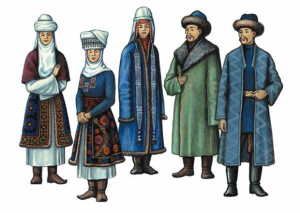
Kyrgyz clothing reflects the lifestyle and regions of Kyrgyzstan, with designs and materials drawn from nomadic life. Wool, felt, leather, skins, and coarse cloth are the main materials used for Kyrgyz clothing, with ornamentation taken from tribal traditions and nature. Even though many people wear Western clothing, traditional elements are still visible everywhere, and people are proud of their traditional clothing in Kyrgyzstan.
The kalpak is perhaps the most famous item of clothing in Kyrgyzstan. A tall hat, made of white felt, it is usually worn by men after the age of 6. Men also wore a chapan, a coat with a high collar, and suede or leather trousers. Sometimes honored guests are presented with an intricately embroidered kalpak and long embroidered felt coat, called a chepken.
Women often wore a beldemchi, a skirt with a slit in the front, over a basic dressing gown or dress. For ceremonial occasions, dresses with ruffles on the sleeves and skirt are the most common, worn with embroidered vests and conical hats with feathers in the top (called shokulo). A large headdress made of up to 30 m (100 feet) of intricately wrapped fabric, called an elechek, was traditionally worn by women, and is still popular for ceremonies and festivals today.
While nowadays clothing is much more Western than traditional, visitors should still be conscious of cultural difference regarding dress. In Bishkek, anything can be worn without attracting attention, but in Osh and in villages, visitors should dress more conservatively to avoid drawing unwanted attention.
NATIONAL CLOTHING OF THE TATAR PEOPLE
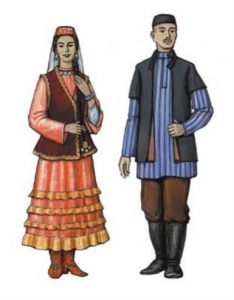
Traditional Tatar female clothes shared many elements with men’s clothing, including long shirts (kyul’mek) and trousers (yshtan). Women’s clothing was typically adorned with embroidery and trim and included velvet camisoles and an apron. One unique element of Tatar women’s clothing was the kalphak. Tatar women also wore various headgears, such as shawls (yaulyk), ear-flaps, and so on. The Tatars often wore leather boots (kata, chitek, kevesh) and multicolored shoes. Young women even wore breast ornaments made from corals and coins. While Tatar girls would often walk with uncovered heads, adult women would typically wear cotton shawls as a manner of dress.
Men’s traditional clothing included broad and long shirt sleeves called kyul’mek. Usually it was assembled with easy-to-wear dressing gowns with straight backs (yshtan), and camisoles (kamzun). During the winter months, men would wear fur coats (tun) or multon coats (tulup). Their headgear would consist of tyubeteika. Headwear included round fur caps, malahay, and hats in the summer and spring, and felt and fur hats in the winter (burek). Popular items of outer clothing for men also included Bukhara dressing gowns (chapan). As well as scarves, which did not have high and turn-down collars.
NATIONAL CLOTHING OF THE BASHKIR PEOPLE
Clothing has always been and remains an integral part of the material culture of the society.
Bashkir national clothes reflect the ancient traditions of Bashkir people and their existence. Bashkir people used traditional materials for the manufacture of clothing. Mainly they used domestic cloth, fabrics made of various threads, sheepskin, firs were the basic materials for making clothes.
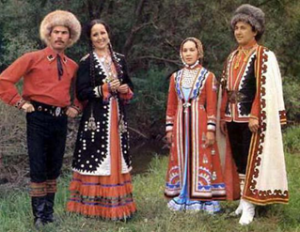
The progress of nation can be seen through the changes in national costume. For example, one of the significant elements of woman’s costume was breastplates (tusheldrek, hakal, yaga) which covered the slit of a dress. The form of breastplates is not identical in different areas: from the form of a triangle to circle, from short to long length till hiplines. Its major attires were artistically liable patterns and gemstones set in silver.
Traditional Bashkir costume is a bright determinant of people’s national identity.
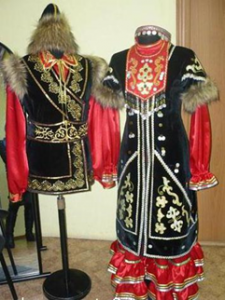
The clothing of the men consisted of a wide and a long shirt with a straight collar neckline, baggy pants, light flared kaftans, vests and fir coats: bille tyn, tire tyn. Men’s hats were tubatais, round furcaps, malakhais , hats. Old men wore hats in black colours while young men’ hats were green, red and blue. Kemer — traditional wide men’s belt with a jewelry clasp.
Bashkir traditional women’s clothing was the most diverse. The basic clothing Bashkir — it dresses in bright colors «kuldek» floor-length skirt with a wide and sewn on her flounces. On the dress Bashkir wore close-fitting vest «kamzul.» Also in the 19th century was the spread apron «alyapkys» of linen fabric. Dark robes «Yelyan» slightly form-fitting at the waist, worn in all areas of Bashkiria. In winter, the rich Bashkir wore coats of expensive fur — fox, marten, beaver, otter.
Traditional costumes are peculiar to or characteristic of a certain nation or ethnic group, which usually retains strong elements of the culture from which it originates.
NATIONAL CLOTHING OF THE KOREAN PEOPLE
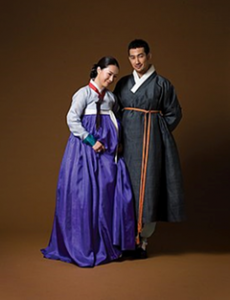
The hanbok (Korean: 한복; Hanja: 韓服; lit. Korean dress) is traditional clothing of the Korean people. The term hanbok is primarily used by South Koreans; North Koreans refer to the clothes as chosŏn-ot (조선옷, lit. ’Korean clothes’). The clothes are also worn in the Korean diaspora, especially by Koreans in China. Koreans have worn hanbok since antiquity. The earliest visual depictions of hanbok can be traced back to the Three Kingdoms of Korea period (57 BC to 668 AD) with roots in the Proto-Koreanic people of what is now northern Korea and Manchuria. The clothes are also depicted on tomb murals from the Goguryeo period (4th to 6th century AD), with the basic structure of the hanbok established since at latest this period. The ancient hanbok consisted of a jeogori (top), baji (trousers), chima (skirt), and the po (coat). The basic structure of hanbok developed to facilitate ease of movement; it integrated many motifs of Mu-ism.
For thousands of years, the hanbok most people wore was pure white with no ornamentation. More ornate hanbok was typically reserved for special occasions such as weddings. The color white was seen as pure. In some periods, commoners (seomin) were even forbidden from wearing colorful hanbok regularly. Modern hanbok are typically patterned after the hanbok worn in the Joseon dynasty, especially those worn by the nobility and royalty.
Jeogori and chima
The jeogori (저고리) is the basic upper garment of the hanbok, worn by both men and women. It covers the arms and upper part of the wearer’s body.There are various styles and types of jeogori varying in fabric, sewing technique, and shape. The basic form of a jeogori consists of gil, git, dongjeong, goreum and sleeves. Gil (길) is the large section of the garment on both front and back sides, and git (깃) is a band of fabric that trims the collar. Dongjeong (동정) is a removable white collar placed over the end of the git and is generally squared off. The goreum (고름) are fabric-strings that tie the jeogori. Women’s jeogori may have kkeutdong (끝동), a different colored cuff placed at the end of the sleeves. Contemporary jeogori are presently designed with various lengths.
Goreum
Goreum (고름) refers to the strings that fasten clothes together.
Traditionally, there are many types of goreum. Fabric goreum were potentially used since Gojoseon. They were originally practical but often decorative. Silla had regulations against types of Dae (belts) and decorative goreum for each Golpoom. Southern parts of Korea, including Silla, had a colorful goreum on the front of the neck, which influenced Yayoi culture. Parts of Goguryeo style had a fabric goreum loop around the waist with a decorative ribbon to the side like a belt. Generally, thin and short ones were used on the inside and more decorative, colourful ones were used on the outside. Since the early form of the jeogori was usually wrapped across the front, the outside goreum was placed on the side of the wearer, below the armpit. Starting in Joseon dynasty, the goreum slowly moved to the front of the jeogori. In the 20th century, the goreum became the commonly known long and wide decorative ribbons on the front of the jeogori and was coined the Ot-goreum.
Chima
Chima (치마) refers to «skirt», and is also called sang (裳) or gun (裙) in hanja. The underskirt, or petticoat layer, is called sokchima. Chima-malgi is the waistband that trims the top of the chima. Chima were typically made from rectangular panels that were pleated or gathered into the chima-malgi (waistband). This waistband also had goreum strings for fastening the skirt around the body. From the Goguryeo to Joseon periods, chima have been striped, pleated, patchworked, and gored.
Sokchima was largely made in a traditional way until the early 20th century when shoulder straps were added, later developing into a sleeveless bodice or «reformed» petticoat called Eo-Kkeh-Heo-ri-Chima. By the mid-20th century, some outer chima also gained a sleeveless bodice, which was then covered by the jeogori.
Baji
Baji (바지) refers to the bottom part of the men’s hanbok. It is the term for «trousers» in Korean. Compared to western style pants, baji does not fit tightly. The roomy design is aimed at making the clothing ideal for sitting on the floor and an ethnic style that dates back to the Three kingdoms period. It functions as modern trousers do and the term baji is commonly used in Korea to refer to every kind of pants.
The baji-malgi is a waistband of the baji that has a long string of goreum.
Baji can be unlined trousers, leather trousers, silk pants, or cotton pants, depending on style of dress, sewing method, embroidery and so on.
Po (포/袍) is a generic term referring to an outer robe or overcoat. There are two general types of po, the Korean type and the Chinese type.
NATIONAL CLOTHING OF THE GERMAN PEOPLE
Tracht in the original German signifies what is worn and the way it is worn, that is a style of clothing and how it is worn or accessorized.Very often these clothes originated as workwear and showed that the wearer belonged to a certain group of people such as officials, workers, a guild, order or a certain city or region.Up and down the country, the Trachten was used to show affiliation to a class, a religion or an ethnic or professional group.
Yet, traditional clothing in Germany used to highlight differences just as much as belonging: the dress code prohibited farmers from dressing like nobility and Germans dressed a certain way to look different from the French.
In the 18th century, traditional clothing became part of folklore to create a sense of German unity and nationality. In the 19th century, the idea of uniform workwear further developed into clothing that despite being simple and traditional was worn in a fine and splendid version to festive events.
Dirndl and Lederhosen are the most recognizable symbols of traditional German clothing. Originating in Bavaria, these iconic outfits have gained popularity throughout the country. The Dirndl, a dress typically featuring a blouse, bodice, skirt, and apron, is often paired with accessories like a handbag or jewelry. Lederhosen, traditionally leather pants for men, are complemented by embroidered shirts and suspenders.
Men’s Clothing: Lederhosen
This Bavarian classic outfit for men is worn at all kinds of festivities. It consists of leather pants, a shirt, knitted stockings and leather shoes, traditionally worn with a hat and other accessories.
Lederhosen can be short, only reaching the thigh, be of a knicker bocker style or go all the way to the ankles. They feature a bib with deer horn buttons and are worn with H-shaped suspenders over the shirt. The outfit originated in the mountain regions of Bavaria from where it spread to the lowlands as well. There are at least six main regional variations with further minor variations and local styles.
Women’s Clothing: the Dirndl
The Dirndl is a traditional outfit for women also originating from Bavaria’s Alpine region, but many variations exist. Other Alpine countries such as Austria, Liechtenstein, Switzerland and Italy all have local variations and traditions.
The traditional Dirndl consists of a dress with a tight bodice and a deep round or rectangular neckline. An apron is worn over a wide skirt with a high waist and varying lengths. Local and generic variations exist as well as simple and exquisite, expensive designs.
NATIONAL CLOTHING OF THE UIGHUR PEOPLE
The traditional dress of the Uyghur people is deeply intertwined with both their history as traders along the Silk Road and their devout belief in Islam. In particular, two pieces of clothing have become symbolic of the Uyghur ethnic minority: the chapan and the doppa. The chapan, a variant of the caftan, is a long coat that is worn over the clothes during the winter months. It is typically worn by men and comes in a variety of colours, from muted blues to fiery reds. Intricate patterns are embroidered on the exterior and, instead of buttons, the chapan is bound by a large cloth band around the waist.
The doppa is a square or round skullcap that is worn not only by the Uyghurs but also by the Kazan Tartars, the Uzbeks, and the Tajiks. The cap itself is usually black or white, although other colour variants do exist, and it is traditionally embroidered with vibrantly colourful patterns, much like the chapan. Older Uyghur men are known to grow long beards and wear a much taller version of the doppa, which is fringed with fur at the bottom.
While men sport the chapan, women wear exquisitely embroidered long-sleeved dresses that billow out at the waist. Popular embroidery motifs include vines, pomegranates, moons, arabesques, and geometric patterns. Golds, reds, and blacks are the most popular colour combinations, although pinks, greens, blues, purples, and even tie-dyes also feature. To complement these luxurious dresses, Uyghur women don plenty of jewellery, including large earrings, bracelets, and necklaces.
Young girls tend to braid their hair in a number of long plaits, as this is regarded as a symbol of feminine beauty, while married women usually wear two plaited pigtails affixed to the head with a crescent-shaped comb. Although it is still reasonably uncommon, some women will wear the veil in-keeping with their Islamic faith. Both men and women wear silk slippers or leather boots, depending on the season and the occasion. From shimmering satins to rich silk threads, the opulence of the Uyghurs’ traditional dress is undeniable.
NATIONAL CLOTHING OF THE UKRAINIAN PEOPLE
Ukrainian national clothing is the clothing worn by people living in Ukraine, mainly ethnic Ukrainians. The most famous Ukrainian clothing items are the embroidered shirt (vyshyvanka), a cloth sash and a vinok flower crown.
Shirts
The embroidered sorochka shirt (Ukrainian: сорочка), also known as vyshyvanka, is the most important element of the Ukrainian costume. Vyshyvankas were typically made from hemp of linen and differed significantly between regions, in both cut and decor.
The earliest vyshyvankas appeared in Ukrainian villages in the middle of the 18th century despite the fact that Ukrainian embroidery is known from 10 to 11 centuries, but it is limited to goldwork for the feudal nobility. After villagers started making vyshyvankas, they acquired a new symbolic meaning as magic talismans and even started being seen as wearer’s substitution: for example, selling one’s own vyshyvanka would result in selling one’s happiness.
The typical silhouette of a Ukrainian shirt included a long straight sleeve that ends with a wristband cuff; the typical adornment was located at the cuff, the sleeve above the elbow and the shoulder, which is a custom adopted from Byzantium along with Christianity. The cut, colours, sewing and decorating techniques, the shape of the collar, the sleeve’s shape and manner of attachment to the body are varied between regions.
Sashes and head coverings
Vinok, or the wreath, is the third national symbol of Ukraine. Flower crowns were worn by unmarried women and brides during the wedding, but the symbolic meaning of the wreath is wider: vinok is an ancient pagan talisman, it is used in the winter holiday season divination [uk] and other rituals. In winter time, wreaths were made from hay, wool, feathers and dried plants and leaves. Regional vinok variants include the feathered karabulya (Ukrainian: карабуля) from Carpathian Bukovina, silk ribbon wreaths of Kyiv and Poltava oblasts and others.
The married women’s head covering, ochipok, was mainly an indicator of the wearer’s marital status: she had to cover her hair after the wedding ceremony. The ochipok was in turn often covered by a piece of cloth (a namitka wimple or a khustka kerchief).
Shoes
Polissya Ukrainians wore bast shoes (lychaky) while Carpathians had their postoly shoes made from leather; choboty boots with a seamed or seamless shaft were popular throughout Ukraine.
Outer garments
Kozhukh fur coats are prominent in Ukrainian culture as fertility-related symbols: the kozhukh turned inside out covered the bench from which the parents blessed their children’s wedding; it also covered the seat of the bride during the unbraiding and the marital bed. A kozhukh worn wrong side out was worn by the bride’s mother before the marriage. Kozhukhs could be decorated with black and grey wool, appliqué, embroidery and sewn-up colourful stings.
Colour and motifs
The most prominent colour of Ukrainian clothing is red. It can be found in every region, especially on festive clothing where it dominates. Polesian daily clothing is also decorated with red and white ornaments while Podoliyan costume was mainly using black and white; Hutsuls used a lot of orange and yellow while the clothing of Carpathian Ruthenia and Lemko Region employed blue even on festive wear.
NATIONAL CLOTHING OF THE CHECHEN PEOPLE
Women’s suit
Chechen women wore a headscarf as a symbol of chastity. It was considered a symbol of social power and the preservation of the sacred purity of women. Women’s clothing varied in materials, colors and patterns. It was an indicator of a woman’s social and age status. The outfit consisted of a tunic dress, an outer dress, a belt and a scarf, but could be complemented with various decorations, which also emphasized the woman’s belonging to a certain class.
The tunic dress was made from light, often monochromatic materials and reached to the ankles. The sleeves of the dress were narrow and long, reaching to the wrists, and the stand-up collar was fastened with one button and almost covered the neck. So-called bibs were sewn onto the lower dress.This decoration on the dress was made to order, based on the imagination and financial capabilities of the customer. Breastplates were made of silver, with stones, and sometimes even covered with gold. Over time, these plates began to be made in the form of undergarment fasteners.
A swinging dress (gabali), resembling a robe or cape, was worn on top of the lower one. It was opened to the waist to show the bibs, and fastened at the waist with small hooks, hugging and emphasizing the figure. Gabali was usually made of velvet, satin, brocade and cloth. There was a variety of colors, styles and materials here. They were often decorated with gold embroidery, braid, frills, and folds. Adult women did not wear g1abali, as it was considered too bright for them, a ceremonial outfit.
The belt gave special beauty to the robe. It was made individually to order, most often from silver. This detail of the national costume is considered the most valuable. Sometimes silver was plated with gold, decorated with stones and various engravings.
The outfit was complemented by a scarf (kortal). Young girls and women tied long scarves and scarves made of light material on their heads. Elderly women wore large scarves with fringes and a bag into which their hair was thrown (chukhta). Women threw braided braids into the chukhta and put it on their head like a hat so that the hair was not visible, and a large scarf was thrown over it.
Men’s suit
The men’s suit consisted of a beshmet, a Circassian coat and trousers. Also integral parts of this outfit were a hat, a belt and a dagger.
The beshmet was a half-caftan that emphasized the silhouette of the highlanders, their courageous figure. It tightly fitted the torso and diverged from the waist down almost to the knee. The stand-up collar was fastened at the neck with several buttons and almost completely covered it. Beshmet usually consisted of lightweight materials that did not restrict movement. Festive versions of the beshmet were made from beautiful and shiny materials, such as satin, and could surprise with a variety of colors.
A Circassian coat was worn over the beshmet. It was not very different from general Caucasian men’s clothing. The Circassian-Caucasian peoples borrowed details fThe Circassian coat resembled a cape, which was fastened at the waist and widened at the bottom. The length of the Circassian coat was usually below the knees, but adult men could wear it longer. Bandoliers (gas holders) were sewn onto the chest on both sides of the Circassian coat, into which charges for weapons were inserted. A thin belt was tied around the waist, into which a dagger (checker) was inserted.rom each other, and it is difficult to judge how this style was formed.
The men had light leather boots on their feet that went up to the knee. Pants were also tucked in there, which were also made of lightweight material and tapered downward to make them easier to tuck into boots.
The look was completed by a papakha. The headdress in the Caucasus is a symbol of courage. Touching a man’s hat meant inflicting a mortal insult, which could end tragically. There are many stories about how men died without taking off their hats in front of their enemies, without losing their honor and dignity.
NATIONAL CLOTHING OF THE INGUSH PEOPLE
The most striking and expressive item of material culture of every nation is clothing. Among the Ingush it was varied. The needs for clothing and fabrics were met from the local raw material base, while imported fabrics were also used.
Every family knew how to sew; women did this. Men’s clothing was strict and modest, well adapted to local conditions, and at the same time distinguished by simplicity and elegance, which met their moral and aesthetic needs.The main elements of a men’s costume were a shirt, trousers, a beshmet, a Circassian coat, a headdress, shoes and weapons. The beshmet was everyday clothing, the Circassian coat was worn on occasions when they went to visit, to a party, to a mosque, or village gatherings. Gazyrnitsa were sewn on both sides of the Circassian coat. Outerwear also included a burka and a sheepskin coat. As a headdress, the Ingush wore a hat (eltar-kiy) in winter and a hat (mangal-kiy) in summer. At the beginning of the 20th century. They began to wear caps later than hats. The shoes were varied — leggings, rawhide shoes. Later, boots (ikkash) and galoshes appeared. Women’s everyday clothing was a shirt dress (koch) and trousers worn underneath (sharbal).
Women’s festive costume was chukhi, which was made of silk, velvet and brocade. The attributes of the chukkha were caps in the shape of a truncated cone with gold and silver embroidery, as well as special bibs with clasps and a belt made of bronze and silver plates, decorated with engraving, niello, granulation, gilding, and semiprecious stones.
Women’s headdresses were varied — scarves, shawls, and also a special horn-shaped headdress — kurkhars. The Ingush women’s footwear consisted of soft morocco boots and flat-toed shoes without a back. Shoes were made from rawhide and morocco, which confirmed the spread of leather craft among the Ingush.In addition to shoes, leather was used to make pouches, belts, covers, saddles, harnesses, etc. The development of weaving is evidenced by spindle whorls found as a result of archaeological excavations. Among home-made fabrics, cloth occupied the first place, which was associated with the development of sheep farming.
NATIONAL CLOTHING OF THE GREEK PEOPLE
Ancient Greeks wore simple garments that draped over their bodies. The chiton and peplos were both simple outfits made from one-piece rectangles of fabric, with holes cut out for the head. The peplos was sleeveless, while the chiton covered part of the arms. Over this, people could wear a cloak called a himation. These outfits were usually made of wool, a fabric used frequently in Greek clothing, due to the prevalence of sheep farming in Greece and the country’s surprisingly cool winters. Linen was also traditionally used for clothing worn during the hot Mediterranean summers.
While Greeks today mainly wear modern «global» style clothing, they still don traditional regional costumes for festivals and national holidays. These costumes’ styles vary between the mainland and the islands, but many contain some elements of the ancient draped garments, and they all have some similar components in terms of materials and basic construction.
Once worn by fighters in the 1821 War of Independence, the traditional costume for men on mainland Greece features a kiltlike garment known as a foustanella. For example, the national costume — today the uniform for the Evzones, the presidential guard — includes a white foustanella that has 400 pleats, symbolizing the 400 years Greece was ruled by the Ottomans. That’s paired with a wide-sleeved white shirt and topped off with an embroidered woolen vest. Long, white socks, a sash and pointed shoes called tsarouhia — topped with their recognizable large pompons — complete the outfit.
Traditional women’s clothing in Greece also varies from region to region, but these outfits also contain similar elements. Most traditional costumes for women have a simple cotton dress as a base, with a sleeveless wool vest over it. To this, women may add aprons, sashes and, perhaps most importantly, large head scarves.
One example of a traditional outfit for women is the karagouna. This traditional wedding dress from Central Greece is very colorful and can be quite heavy. Like some other traditional Greek costumes, it includes many layers, starting with a black-fringed white underdress. Over that, women wear a few different coats, starting with an embroidered wool coat, followed by a long white sleeveless coat and then another embroidered waistcoat. This is all topped by a red apron. A woman wearing a karagouna will also don a head kerchief and chains of gold coins across her forehead and bosom to signify wealth. Traditional costumes have their place, but so do traditional customs.
NATIONAL CLOTHING OF THE TAJIK PEOPLE
Tajik traditional clothes differ from region to region in terms of color, mbroidered patterns, style. But there are some common features in every national costume.
A tunic-type shirt, wide trousers, a quilted dressing gown, a waist scarf, a skull-cap or a turban, leather boots, galoshes with pointed toes (which are frequently worn over boots ) — for men, a tunic-type dress, wide trousers, a kerchief or a skull-cap — for women. Modern peasants still adhere to the national style in clothes.
Girls and women wear skullcaps and scarves mostly for various occasions (weddings, birthdays). National jewelry is mostly made of silver. They are very massive, forged, embossed: necklaces, pendants, earrings and rings.
Rumol is men’s cotton waist kerchief, decorated with embroidery of various colors — by basma stitch or double-sided satin stitch. Patterns of floriated nature resembling Arab script predominate mainly on them.
Toki – kallapush (skull cap) is a traditional part of the national Tajik costume. The most popular are “chusti”, men’s black and white skull caps with bodoms (almond) or kalamfurs (capsicum) embroidered on white silk. Along with them, however, light semi-spherical machine-embroidered skull caps – arakhchin are met in many areas of Tajikistan. There are several traditional types of composition and ornamental patterns for them. Women’s square skull caps with bright “florinated” patterns embroidered with cross stitch are widely used. Tajik round flat-bottomed skull caps embroidered with satin stitch with colored silk sowings are also known in Pamir.
NATIONAL CLOTHING OF THE KARACHAY PEOPLE
Women’s clothing retained elements of the costume of the Alan period. These include, for example, the presence of metal rims, decorated with stamped, dotted, geometric patterns, which were sewn to the headdress. This headdress was a tall, pointed, woven cap, onto the top of which metal caps covered with a pattern were sewn (sometimes with a ball on the top). It should be noted that in Karachay, the bronze and silver plates that adorned these caps and, obviously, clothing, as well as the tops for the caps and rims, were covered with a stamped punch pattern, characteristic of the Alans of the early Middle Ages. The medieval Karachay dress was decorated with silver breast buckles and buttons sewn in two rows to the fabric.
Medieval traditions persisted until the 19th century. This especially applies to headgear. Girls’ festive dresses were made of velvet or silk in dark red, less often blue and green. They were decorated with gold embroidery and braid. The hats (ok’a berk) were also richly decorated. An integral part of a woman’s costume was the belt (kamar), which was a genuine work of jewelry art. Men’s clothing is more similar to the clothing of other mountain peoples of the North Caucasus:
- Tunic-like undershirt.
- Beshmet (kaptal) made of black, white fabric, sometimes (holiday) bright colors — bright blue, orange, striped. In everyday life, the beshmet was worn without a Circassian coat.
- The Circassian coat (chepken), as a rule, was weekend and holiday clothing. It was sewn mainly from black, grey, brown and white materials. The length of the Circassian coat usually reached the knees and below. The Circassian coat had a cutout on the chest and overhead gazyrs. Gazyrs were decorated with a chased or cast silver pommel, often with niello.
- The belt (belibau) was a narrow leather belt with silver plaques and leather pendants, with silver tips. It was a mandatory attribute of a men’s suit. It was worn on a Circassian coat, and if the man was without one, on a beshmet.
- Pants (kenchek) had straight, narrow, slightly tapered legs, with a large diamond-shaped wedge (ay) between them. The width of the wedge sometimes reached 80-90 cm.
- Leggings (yshim) were worn over the pants, reaching to the knees and above. The leggings were tied under the knees with leather straps (yshim bau).
- Chabyrs — shoes made of rawhide, made from one piece of leather with a seam at the back. They reached the ankles, where they were secured with a strap. They were worn on bare feet, and special straw was placed in them. In winter they wore felt shoes (yuuk). Chabyrs, like uyuk, were also worn by women.
- The headdress was similar to the headdress of other highlanders. The Karachais wore fur hats (teri berk) and felt hats (kiyiz berk). A tall astrakhan hat (buhar berk) was considered a festive headdress for men, which was passed down to the Cossacks under the name kubanka. An element of camping clothing was a burka and a bashlyk.
NATIONAL CLOTHING OF THE BALKAR PEOPLE
Women’s clothing retained elements of the costume of the Alan period. These include, for example, the presence of metal rims, decorated with stamped, dotted, geometric patterns, which were sewn to the headdress. This headdress was a tall, pointed, woven cap, onto the top of which metal caps covered with a pattern were sewn (sometimes with a ball on the top).
Men’s clothing is more similar to the clothing of other mountain peoples of the North Caucasus:
— Tunic-like undershirt.
— Beshmet (kaptal) made of black, white fabric, sometimes (holiday) bright colors — bright blue, orange, striped. In everyday life, the beshmet was worn without a Circassian coat.
— The Circassian coat (chepken), as a rule, was weekend and holiday clothing. It was sewn mainly from black, grey, brown and white materials. The length of the Circassian coat usually reached the knees and below. The Circassian coat had a cutout on the chest and overhead gazyrs. Gazyrs were decorated with a chased or cast silver pommel, often with niello.
— The belt (belibau) was a narrow leather belt with silver plaques and leather pendants, with silver tips. It was a mandatory attribute of a men’s suit. It was worn on a Circassian coat, and if the man was without one, on a beshmet.
-Pants (kenchek) had straight, narrow, slightly tapered legs, with a large diamond-shaped wedge (ay) between them. The width of the wedge sometimes reached 80-90 cm.
— Leggings (yshim) were worn over the pants, reaching to the knees and above. The leggings were tied under the knees with leather straps (yshim bau).
— Chabyrs — shoes made of rawhide, made from one piece of leather with a seam at the back. They reached the ankles, where they were secured with a strap. They were worn on bare feet, and special straw was placed in them. In winter they wore felt shoes (yuuk). Chabyrs, like uyuk, were also worn by women.
The headdress was similar to the headdress of other highlanders. The Karachais wore fur hats (teri berk) and felt hats (kiyiz berk). — A high astrakhan hat (buhar berk) was considered a festive headdress for men, which was passed on to the Cossacks under the name kubanka.
An element of camping clothing was a burka and a bashlyk.
Medieval traditions persisted until the 19th century. This especially applies to headgear. Girls’ festive dresses were made of velvet or silk in dark red, less often blue and green. They were decorated with gold embroidery and braid. The hats (ok’a berk) were also richly decorated. An integral part of a woman’s costume was the belt (kamar), which was a genuine work of jewelry art.
NATIONAL CLOTHING OF THE POLISH PEOPLE
In the period from the XIII to the XVI centuries. in Polish society there was a process of separation of peasants, townspeople (burghers) and gentry. This ever-deepening social difference gave rise to three types of clothing. The Polish national costume has come a long way until it has acquired common features in all regions of the state.
Initially, all clothing in Poland was divided into 3 large groups depending on the social status of a person: urban, gentry and peasant. The first two groups were often subject to changes, while peasant clothing underwent changes rarely and very slowly. The most widespread was the gentry costume, which absorbed many features from the peasant group of clothing and became popular among the entire people.
The division of Polish clothing into groups was associated with the quality of the material that was used to sew the products. Clothes for peasants and townspeople were made mainly from linen. In the national clothing of the Polish gentry, expensive natural wool fabric predominated. The set of the Polish national costume, regardless of the region in which it is common, includes (taking into account gender):
skirt;
shirt;
apron;
vest (corset);
belt;
trousers;
headdress;
special shoes (“kerpchi”);
decorations and additional accessories.
Basically, the colors used in Polish costume are red, brown, blue, green and their various shades. Often there are rainbow models, clothes with floral motifs, various decorative prints and inserts. Particular attention is paid to the headdress. Young girls and women wear bright, original scarves, flower crowns, married ladies wear caps.
Jewelry is also an integral part of the national costume in Poland. Most often they are red and come in the form of massive beads, bracelets, and earrings.
NATIONAL CLOTHING OF THE JEWISH PEOPLE
Jewish religious clothing is apparel worn by Jews in connection with the practice of the Jewish religion. Jewish religious clothing has changed over time while maintaining the influences of biblical commandments and Jewish religious law regarding clothing and modesty (tzniut). Contemporary styles in the wider culture also have a bearing on Jewish religious clothing, although this extent is limited.
Men’s clothing
Many Jewish men historically wore a turban or sudra, a tunic, a tallit, and sandals in summer. Oriental Jewish men in late-Ottoman and British Mandate Palestine would wear the tarbush on their heads.
The tallit is a Jewish prayer shawl worn while reciting morning prayers as well as in the synagogue on Shabbat and holidays. In Yemen, the wearing of such garments was not unique to prayer time alone but was worn the entire day. In many Ashkenazi communities, a tallit is worn only after marriage. The tallit has special twined and knotted fringes known as tzitzit attached to its four corners. According to the Biblical commandments, tzitzit must be attached to any four-cornered garment, and a thread with a blue dye known as tekhelet was originally included in the tzitzit. However, the missing blue thread does not impair the validness of the white.
Kippah
A kippah or yarmulke (also called a kappel) is a thin, slightly-rounded skullcap traditionally worn at all times by Orthodox Jewish men, and sometimes by both men and women in Conservative and Reform communities. Its use is associated with demonstrating respect and reverence for God. Jews in Arab lands did not traditionally wear yarmulkes, but rather larger, rounded, brimless hats, such as the kufi or tarboush.
Kittel
A kittel is a white, knee-length, cotton robe worn by Jewish prayer leaders and some Orthodox Jews on the High Holy Days. In some families, the head of the household wears a kittel at the Passover seder, while in other families all married men wear them. In many Ashkenazi Orthodox circles, it is customary for the groom to wear a kittel under the chuppah.
Women’s clothing
Married observant Jewish women wear a scarf (tichel or mitpahat), snood, hat, beret, or sometimes a wig (sheitel) in order to conform with the requirement of Jewish religious law that married women cover their hair. Jewish women were distinguished from others in the western regions of the Roman Empire by their custom of veiling in public. The custom of veiling was shared by Jews with others in the eastern regions.
NATIONAL CLOTHING OF THE CHINESE PEOPLE
Hanfu (simplified Chinese: 汉服; traditional Chinese: 漢服; pinyin: Hànfú, lit. «Han clothing»), are the traditional styles of clothing worn by the Han Chinese since the 2nd millennium BCE. There are several representative styles of hanfu, such as the ruqun (an upper-body garment with a long outer skirt), the aoqun (an upper-body garment with a long underskirt), the beizi and the shenyi, and the shanku (an upper-body garment with ku trousers).
Traditionally, hanfu consists of a paofu robe, or a ru jacket worn as the upper garment with a qun skirt commonly worn as the lower garment. In addition to clothing, hanfu also includes several forms of accessories, such as headwear, footwear, belts, jewellery, yupei and handheld fans. Nowadays, the hanfu is gaining recognition as the traditional clothing of the Han ethnic group, and has experienced a growing fashion revival among young Han Chinese people in China and in the overseas Chinese diaspora.
After the Han dynasty, hanfu developed into a variety of styles using fabrics that encompassed a number of complex textile production techniques, particularly with rapid advancements in sericulture. Hanfu has influenced the traditional clothing of many neighbouring cultures, including the Korean Hanbok, the Japanese kimono (wafuku), the Ryukyuan ryusou, and the Vietnamese áo giao lĩnh (Vietnamese clothing). Elements of hanfu design have also influenced Western fashion, especially through Chinoiserie fashion, due to the popularity of Chinoiserie since the 17th century in Europe and in the United States.
